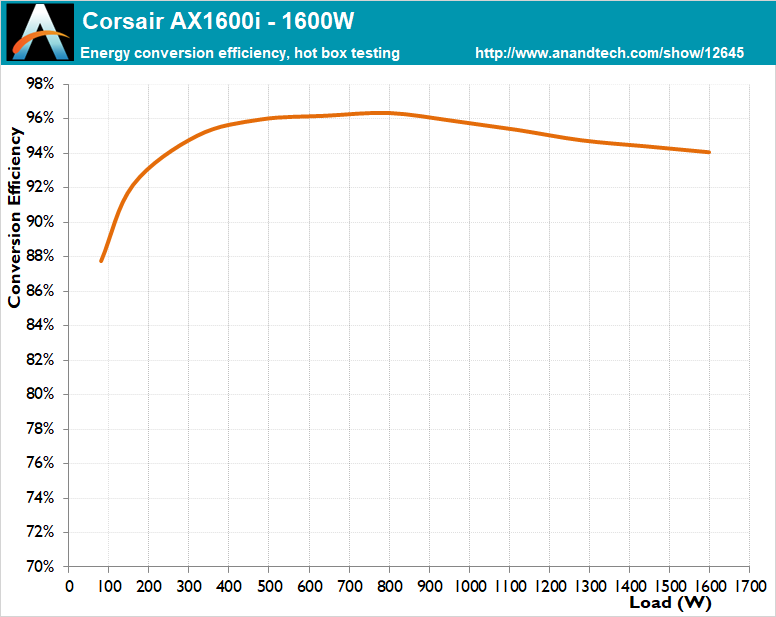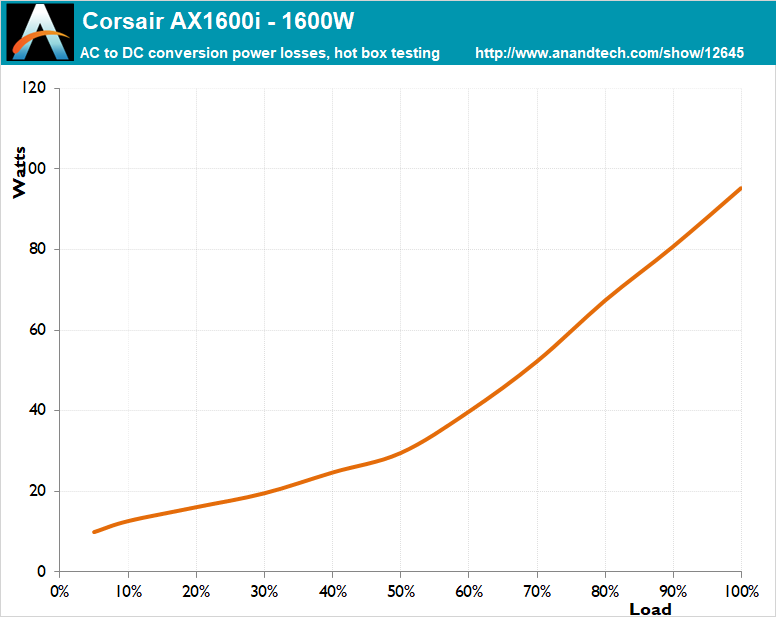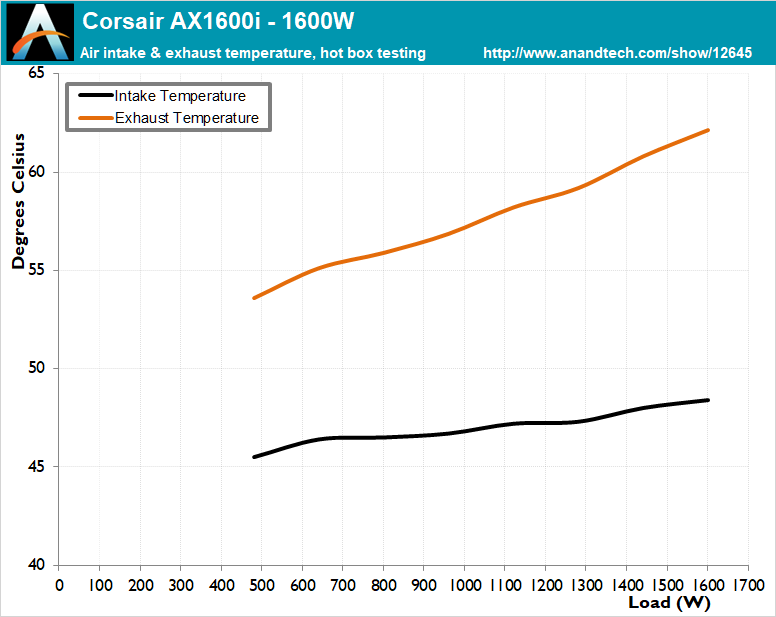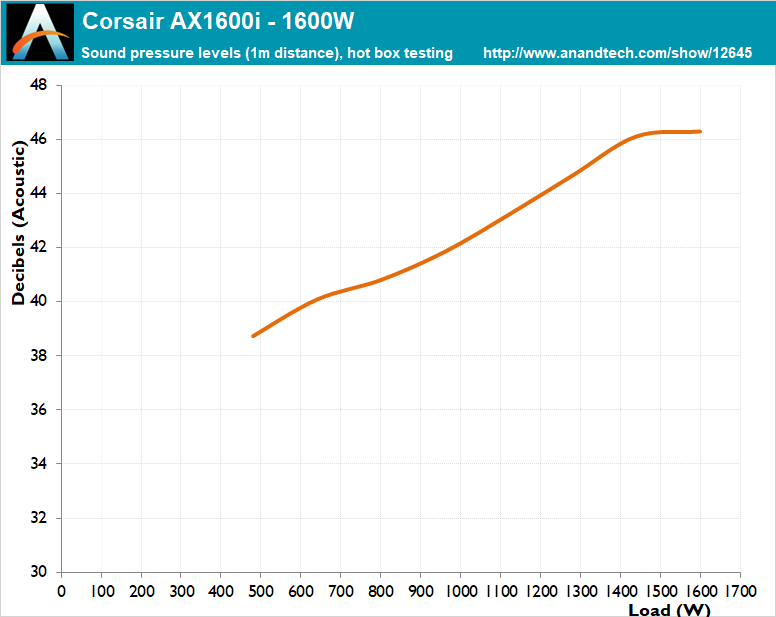The Emperor of Efficiency: Corsair's AX1600i PSU Rules Alone (Review)
by E. Fylladitakis on April 18, 2018 9:30 AM ESTHot Test Results
The Corsair AX1500i already was the benchmark of electrical quality, leaving very little room for improvement. Although the AX1600i might appear to deliver a little bit better power quality, the truth is that we would need very high precision equipment to tell the difference between the two, and any difference would be unimportantly small. However, that does not lessen the fact that the AX1600i delivers possibly the best power quality that can be bought at this point of time. For the most part, the voltage ripple of any line is less than ten millivolts. The maximum ripple on the 12V line is just 14 mV and that is with a massive current draw of almost 124 amperes. The voltage regulation is equally impressive, with a variation of just 0.2% on the 12V line across the nominal load range. Voltage regulation is a little bit worse on the 3.3V/5V lines, at 0.4%/0.25% respectively, which figures still are a lot better than what most current high-performance PSUs can achieve.
| Main Output | ||||||||
| Load (Watts) | 321.91 W | 804.24 W | 1205.17 W | 1606.8 W | ||||
| Load (Percent) | 20.12% | 50.26% | 75.32% | 100.42% | ||||
| Amperes | Volts | Amperes | Volts | Amperes | Volts | Amperes | Volts | |
| 3.3 V | 2.78 | 3.33 | 6.96 | 3.33 | 10.44 | 3.31 | 13.92 | 3.31 |
| 5 V | 2.78 | 5.05 | 6.96 | 5.05 | 10.44 | 5.04 | 13.92 | 5.03 |
| 12 V | 24.74 | 12.07 | 61.85 | 12.06 | 92.78 | 12.05 | 123.71 | 12.05 |
| Line | Regulation (20% to 100% load) |
Voltage Ripple (mV) | |||||
| 20% Load | 50% Load | 75% Load | 100% Load | CL1 12V |
CL2 3.3V + 5V |
||
| 3.3V | 0.4% | 6 | 10 | 12 | 12 | 4 | 10 |
| 5V | 0.25% | 4 | 6 | 10 | 10 | 6 | 12 |
| 12V | 0.2% | 6 | 8 | 10 | 14 | 12 | 6 |
When it comes to adverse ambient conditions, the Corsair AX1600i is a true fortress. Operating the AX1600i inside our hotbox had virtually no impact on its electrical performance and/or efficiency. Even though the ambient temperature was well over 45 °C, the efficiency drop across the entire range was a mere 0.1%. This suggests that the components of the AX1600i are far from getting thermally overstressed, even with the PSU operating at maximum output under these adverse conditions.
The only thing inside the AX1600i that is affected by the high ambient temperature is the cooling fan. It will still not even start with a load below 460 Watts but it is livelier once it does start, increasing its speed at a higher rate as the load increases. It ultimately reaches about 45.5 dB(A) at maximum load, which would be a low figure even for a mainstream PSU with an output of some hundred Watts, yet the AX1600i manages to maintain comfortable noise levels operating at maximum load with an ambient temperature of over 48°C. The internal temperatures of the PSU also are very low taking its power output and low fan speed into account.















39 Comments
View All Comments
zodiacfml - Thursday, April 19, 2018 - link
I have two rated 2000W PSUs and one 1800W. I am not capable of measuring its efficiency but I once compared its power consumption to a 650W Bronze PSU with a 300 watt load. The consumption at the wall are similar. I've read some comments that they cannot keep up with 100% load but I don't have such requirements.This leads me to think that the Chinese branded 2000W PSU(~$130) has a 90% or higher efficiency at 50% load.
dgingeri - Wednesday, April 18, 2018 - link
Nice! It actually beats my HX750i at my idle load (~110W at 86% efficiency). I have been hard pressed to find a better PSU than my HX750i.Ninjawithagun - Thursday, May 10, 2018 - link
My 'old' AX1500i easily maintains 97% efficiency at 600W output. To add to that amazing efficiency, the PSU fan rarely ever turns on, which means silent gaming for my custom watercooled system ;-)AdrianB1 - Wednesday, April 18, 2018 - link
Give me one with 350-400W and the same shape of efficiency curve on the reduced power range; make it semi-modular because I don't need to remove the 24 pin ATX cord. It is perfect for a modern computer with a 95W TDP processor and a 150W TDP GPU.I have the Corsair PSU that has some of these specs, but not the efficiency: Corsair TX550M; semi-modular, fair output power, low efficiency especially at 100W when I watch Netflix.
Jon Tseng - Wednesday, April 18, 2018 - link
Agree it looks overspecced, but thinking about silver linings I guess if you ran one of these at reduced load to serve say an 800W system it would be significantly cooler/quieter than an 800W PSU running at full load?PeachNCream - Wednesday, April 18, 2018 - link
The sound measurements are in the review as is a statement that the fan doesn't even turn on at sub-600W loads in the cold test results. At 800W loads, it produces 35 (cold) to 41 (hot) decibels making it very likely to be much quieter than any 800W PSU running at full load.Stas - Thursday, April 19, 2018 - link
that's how you're supposed to spec out a PSUJohnUSA - Wednesday, April 18, 2018 - link
I read that an actual owner who liked this very expensive model but hated its poor and cheap cables, and many of these cables were also quite short.Shame on the manufacturer to have such bad shortcomings and put an exorbitant price on this model.
Hope they will fix these issues immediately.
nowwhatnapster - Friday, April 20, 2018 - link
I doubt it, they want to push those premium sleeved cables. It would be nice if they were individually sleeved, but then it would be a $600 psu and you might want different colored sleeving at that price. Makes sense to sell the premium cables separate.I agree the stock cables are very ridged due to the in line capacitors. I used them for a brief time. They get the job done and do not compromise on quality, but they sacrifice aesthetics and usability.
bug77 - Wednesday, April 18, 2018 - link
And here I was thinking efficiency means buying a power supply that fits one's needs. I.e. 600W is more than enough for anyone that doesn't overclock and uses multiple GPUs at the same time...